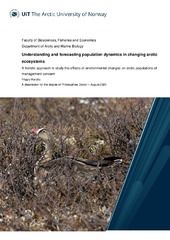| dc.description.abstract | Rapid environmental changes are currently occurring in the Arctic because of global warming. Arctic food webs can exhibit complex dynamics because of the prevalence of tight interactions between trophic levels. Climate change impacts can therefore propagate across food webs and result in non-trivial indirect effects on arctic species and populations. In this thesis, constituted by four papers, I address the general issue of how rapid climate change and other environmental stressors affect the population dynamics of arctic species of management concern. I focused on three target species: the Svalbard rock ptarmigan, the willow ptarmigan, and the lesser white-fronted goose. I based my investigation on long-term time series available for both the study populations and linked ecosystem components. I aimed to infer general ecological mechanisms driving population dynamics of arctic species facing climate change, but also provide recommendations for improved monitoring and management of the study populations. I developed a-priori conceptual models describing climate and management impacts and converted them into advanced statistical models. I found that major changes in winter climate in terms of winter temperature seem to have driven the recent increase in the population of Svalbard rock ptarmigan, while intensified outbreaks of insect pests and delayed onset of winter may have contributed to the decline of willow ptarmigan populations. As stakeholders were interested in having predictions of population density to adapt harvest strategies, I tested the ability of different models to provide near-term forecasts of ptarmigan density. I also found no evidence that predator control contributed to the recent recovery of the endangered Fennoscandian population of lesser white-fronted goose, and that goose breeding success is primarily influenced by population cycles of small rodent species. My thesis constitutes a compelling example of how a holistic approach incorporating food web dynamics can improve our understanding of the multifaceted impacts of environmental changes and aid the management of populations subjected to rapid climate changes. | en_US |
| dc.relation.haspart | <p>Paper I: Marolla, F., Henden, J.A., Fuglei, E., Pedersen, Å.Ø., Itkin, M., Ims, R.A. Iterative model predictions for a high-arctic ptarmigan population impacted by rapid climate change. (Submitted manuscript).
<p>Paper II: Henden, J.A., Ims, R.A., Yoccoz, N.G., Asbjørnsen, E.J., Stien, A., Mellard, J.P., Tveraa, T., Marolla, F. & Jepsen, J.U. (2020). End-user involvement to improve predictions and management of populations with complex dynamics and multiple drivers. <i>Ecological Applications, 30</i>(6), e02120. Also available in Munin at <a href=https://hdl.handle.net/10037/18336>https://hdl.handle.net/10037/18336</a>.
<p>Paper III: Marolla, F., Aarvak, T., Øien, I.J., Mellard, J.P., Henden, J.A., Hamel, S., … Ims, R.A. (2019). Assessing the effect of predator control on an endangered goose population subjected to predator‐mediated food web dynamics. <i>Journal of Applied Ecology, 56</i>(5), 1245-1255. Also available at <a href= https://doi.org/10.1111/1365-2664.13346 > https://doi.org/10.1111/1365-2664.13346 </a>. Accepted manuscript version available in Munin at <a href=https://hdl.handle.net/10037/17028>https://hdl.handle.net/10037/17028</a>.
<p>Paper IV: Marolla, F., Aarvak, T., Hamel, S., Ims, R.A., Kéry, M., Mellard, J.P., … Yoccoz, N.G. Life cycle analysis of an endangered migratory bird shows no evidence that predator control drove population recovery. (Manuscript). | en_US |


 English
English norsk
norsk
